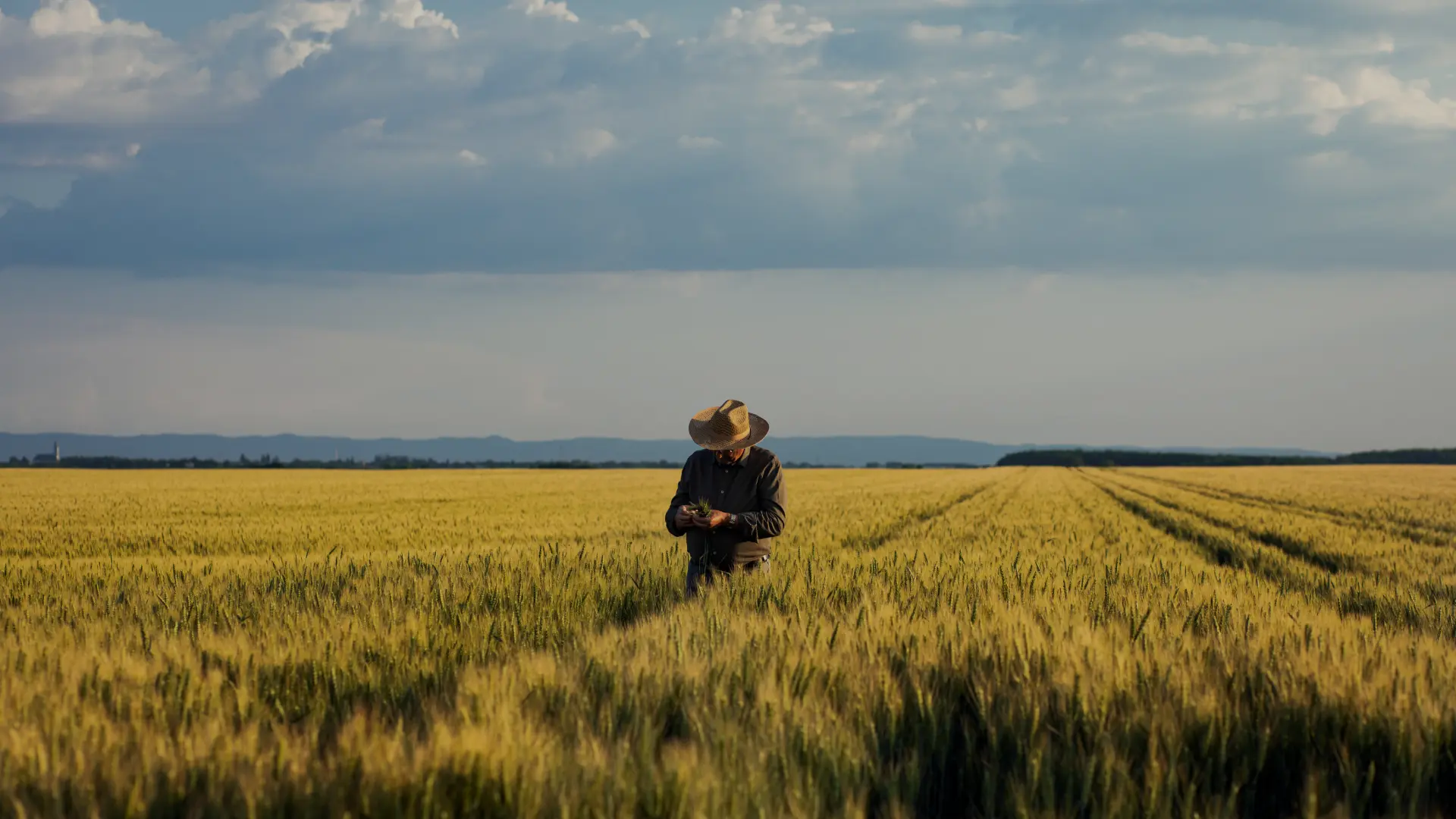Let’s talk about climate action in food and agriculture: how much progress was made in 2023, and where are we headed in 2024?
To begin to answer these questions, Regrow recently welcomed Shalini Unnikrishnan, Managing Director and Partner at Boston Consulting Group, alongside our CEO Dr. Anastasia Volkova for a wide-ranging discussion on key industry trends.
Here, we’ll outline the takeaways from the session, including the relationship between resilient agriculture and food security, the need for innovative financing mechanisms to fund and derisk practice changes, and the role of evolving consumer behavior in driving sustainability initiatives.

On the heels of global climate talks
The latter half of 2023 saw two significant global gatherings on climate action (including land- and agriculture-based action): the Davos — World Economic Forum Annual Meeting and COP28. Anastasia and Shalini called the progress from these meetings ‘pleasantly surprising.’
This year was the first time that COP set aside an entire day for a food and agriculture agenda. 160 countries signed a declaration in support of action in food and agriculture. Groundbreaking coalitions were unveiled — collaborations between corporations, NGOs and research institutions to support climate-friendly food production — and commitments were set by non-state actors. As Shalini mentioned, “I didn’t realize there was so much pent-up energy in this community.”
Now that the energy has been established, it’s time to scale our impact and make real progress. As Anastasia said, “On one hand, I feel a great deal of optimism. The trajectory overall is a positive trajectory. However, we can't do more pilots. We need to scale.”
“Looking back 7 years, adoption rates [for climate-smart farming practices] was 250% growth. But it's extremely small percentages. So whilst we are more than doubling, we're still in single digit percentages of adoption of practices.” — Anastasia Volkova
How can we scale our impact in a way that will allow us to reach our 2030 goals? By understanding the relationship between resilient agriculture and food security, developing financing mechanisms to de-risk climate action, and leveraging consumer behavior in driving sustainability initiatives.
Resilience doesn’t need to come at a premium
How can we fund the transition to sustainability without creating cost barriers?
One of the central themes of the discussion was resilient agriculture in the context of global food security. The speakers underscored that a sustainable and resilient agricultural system is essential to combat the adverse effects of climate change and safeguard the global food supply.
However, we cannot rely on utilizing regenerative practices — and paying a premium for those practices — to establish the scale we need in agricultural resilience.
Food products with sustainable branding have become associated with higher prices and are marketed towards more affluent consumers—those who can show their support for climate-friendly initiatives with their wallet. While this has the positive effect of moving more of the value chain towards regenerative practices, it has contributed to a false narrative that regenerative practices are always costly.
In fact, practices that create more resilience on the farm (ie. better soil health, reduced emissions) are the rational economic choice when viewed on a timeline of multiple harvests. Shalini explained:
“This narrative that regenerative practices require us to pay a premium forever is a little bit founded in false thinking. We’ve done a study in Germany, we've done a study in the U.S. Midwest, and we learned that for farmers, profitability goes up after the first bit of dip [after implementing regenerative practices].
Where we have to support farmers is during the transition phase. After that we have seen 60%, 70% increases in profitability…so we need to disaggregate this dialogue that we need premium pricing for regenerative practices.”
Anastasia emphasized the need for systems that benefit both humans and the planet. She highlighted that regenerative agriculture should not be seen as a premium option but as a fundamental necessity for a livable future.
Both speakers acknowledged that there are places where resilient agriculture will require significant upfront investment, but that as a society we must find a way to pay for it. The future of food security is at stake.
“I cannot imagine a [sustainable] world in which resilient outcomes come at a premium.”
Let’s Fund Farming Better
How can we build the business case for farmer support?
Even accepting that resilient practices create long-term economic value, transitions still must be adequately incentivized and derisked for farmers to take action.
In terms of funding resilient agriculture, the discussion between Anastasia and Shalini made clear that the industry needs to explore innovative financing mechanisms to promote resilient agriculture and regenerative practices. Both speakers stressed the importance of developing financial solutions that can support farmers during their transition to more sustainable methods.
Shalini emphasized the need for a comprehensive toolkit to aid farmers in this transition, including financing players and insurance providers that can take equity stakes. She noted that financial incentives must align with the right outcomes to make sense for farmers.
Anastasia echoed this sentiment, calling for financial institutions to reevaluate their business models to better support farmers in their journey towards sustainability (something we’ve discussed in our 2024 Trends analysis, Seeds of Resilience).
"It has to make economic sense for the farmers. We can't expect them to do all this extra work, or do different work, take on all the risk, and then not compensate them for it." - Shalani Unnikrishnan
Though climate finance is on an upward trajectory, we still need more funding in the agriculture sector in order to scale outcomes. As Shalini noted, within the climate finance sector only about 3% of funding goes to agriculture, despite agriculture contributing ~30% of global greenhouse gas emissions. Anastasia believes there’s major potential for that funding to grow, but only if we understand where funding goes, how it’s distributed and how we can partner to scale impact.
One way to understand funding and finance mechanisms is through consumer behavior — understanding how people are prioritizing agriculture resilience.
From Buyers’ Remorse to Buyers’ Respect
How are consumer choices driving change?
During their conversation, Anastasia and Shalini discussed the evolving expectations of consumers and their potential to drive sustainability and climate investments in agriculture. While acknowledging the gap between consumer intentions and actions, the experts noted a growing awareness and shift in consumer behavior towards more sustainable products.
Shalini highlighted research indicating that linking sustainability narratives to quality and better outcomes for families positively influences consumer behavior. She stressed the importance of clear, simple narratives that resonate with consumers' concerns and priorities.
Anastasia discussed the power of consumer choices, especially for those with the privilege of choice. However, she also raised an essential question about how these choices can be extended to those who are less fortunate.
"Consumer behavior can be shifted for those who have the privilege of choice. But how do these choices trickle down to those who are less fortunate?"
Anastasia highlighted the need for a systemic shift that not only caters to privileged consumers but also ensures food security for the less fortunate.
A Holistic, Landscape Lens Offers Promise
How can systems thinking drive better outcomes?
Shalini’s recent work on the COP28 Action Agenda on Regenerative Landscapes illuminated an important concept for the agricultural value chain to consider in 2024 and beyond.
Highlighting the concept of 'landscape', Shalini pointed out the simple but profound reality that farms do not exist in a vacuum; they have major impacts on local water, biodiversity, forests, and other natural assets. This broader perspective is vital for achieving nature-positive outcomes.
She gave an example illustrating how expanding the circle of stakeholders involved in a program can lead to stacked, mutually beneficial ecosystem outcomes.
“I know one program where it was the water utility who was willing to pay the farmers for regenerative practices, because it was reducing their costs of cleaning and filtering the water from all the nitrogen runoff. It expands the pod, and it gets to nature outcomes.”
Shalini noted that the 'landscape' approach is also compelling from a policy and regulatory standpoint. It operates at a scale that can attract significant attention from policymakers and potentially lead to the creation of new regulatory sandboxes. These sandboxes can allow for experimentation and further definition of transition pathways within specific landscapes.
—
"Building Resilience: Learnings from 2023 & Trends for 2024" provided valuable insights into the challenges and opportunities for climate action in the agricultural sector. As we move forward, it is clear that a concerted effort from all stakeholders will be essential in building a more sustainable and resilient future of food.
Watch the webinar for more takeaways from Anastasia and Shalini, and explore agriculture resilience at resilience.regrow.ag.



